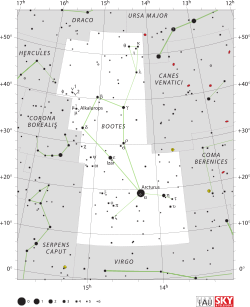Pi Bootis
| Pi Bootis (π) | |
 | |
| Observationsdata Epok: J2000 | |
|---|---|
| Stjärnbild | Björnvaktaren |
| Rektascension | 14t 40m 43,56087s[1] |
| Deklination | +16° 25′ 05,8863″[1] |
| Skenbar magnitud () | 4,5038[1] (4,893 + 5,761)[2] |
| Stjärntyp | |
| Spektraltyp | B9 IIIp (MnHgSi) +A6 V[3] |
| U–B | -0,31[4] |
| B–V | +0,03[4] |
| R–I | -0,02 |
| Astrometri | |
| Radialhastighet () | -1,1 ± 0,8[5] km/s |
| Egenrörelse (µ) | RA: +11,44[1] mas/år Dek.: + 9,47[1] mas/år |
| Parallax () | 10,67 ± 1,35[1] |
| Avstånd | ca 310 lå (ca 90 pc) |
| Absolut magnitud () | -0,39[6] |
| Detaljer | |
| Massa | 3,49 ± 0,14[6] M☉ |
| Radie | 3,2 ± 0,4[6] R☉ |
| Luminositet | 214[6] L☉ |
| Temperatur | 12 052 ± 456[7] K |
| Metallicitet | +0,18 ± 0,17[7] dex |
| Vinkelhastighet | 14,0[8] km/s |
| Andra beteckningar | |
| π Boo, 29 Bootis, BD+17° 2768, HIP 71762, ADS 9338 [9] π1 Bootis: HD 129174, HR 5475, SAO 101138 π2 Bootis: HD 129175, HR 5476, SAO 101139 | |
Pi Bootis (π Bootis, förkortad Pi Boo, π Boo), som är stjärnans Bayer-beteckning, är sannolikt en trippelstjärna i södra delen av stjärnbilden Björnvaktaren. Den har en kombinerad skenbar magnitud av 4,50[2] och är synlig för blotta ögat där ljusföroreningar ej förekommer. Baserat på parallaxmätning inom Hipparcosuppdraget på ca 10,7 mas,[1] beräknas den befinna sig på ett avstånd av ca 310 ljusår (90 parsek) från solen.
Egenskaper[redigera | redigera wikitext]
Primärstjärnan Pi1 Bootis är en blå till vit jättestjärna av spektralklass B9 IIIp (MnHgSi).[3] Det är en kemiskt ovanlig stjärna av HgMn-typ,[8] med ett spektrum som visar anomala överskott av kvicksilver, mangan och kisel.[3] Den har en massa som är ca 3,5[6] gånger större än solens massa, en radie som är ca 3,2[6] gånger solens radie och avger ca 214[6] gånger mer energi än solen från dess fotosfär vid en effektiv temperatur på ca 12 100 K.[7]
Pi1 Bootis är sannolikt en enkelsidig spektroskopisk dubbelstjärna med en okänd följeslagare.[10] Dess synliga följeslagare, Pi2 Bootis, av magnitud 5,76[2] är en vit stjärna i huvudserien av spektralklass A6 V,[3] som år 2010 var separerad med 5,537 ± 0,003 bågsekunder vid en positionsvinkel på 110,5° ± 0,5°. Detta motsvarar en projicerad separation av 538,6 ± 47,7 AE.[10]
Referenser[redigera | redigera wikitext]
- Den här artikeln är helt eller delvis baserad på material från engelskspråkiga Wikipedia, 14 april 2019.
Noter[redigera | redigera wikitext]
- ^ [a b c d e f g] van Leeuwen, F. (2007), "Validation of the new Hipparcos reduction", Astronomy and Astrophysics, 474 (2): 653–664, arXiv:0708.1752, Bibcode:2007A&A...474..653V, doi:10.1051/0004-6361:20078357.
- ^ [a b c] Høg, E.; et al. (2000), "The Tycho-2 catalogue of the 2.5 million brightest stars", Astronomy and Astrophysics, 355: L27, Bibcode:2000A&A...355L..27H, doi:10.1888/0333750888/2862.
- ^ [a b c d] Abt, H. A.; Cardona, O. (January 1, 1984), "The nature of the visual companions of Ap and Am stars", Astrophysical Journal, Part 1, 276: 266–269, Bibcode:1984ApJ...276..266A, doi:10.1086/161610.
- ^ [a b] Nicolet, B. (1978), "Photoelectric photometric Catalogue of homogeneous measurements in the UBV System", Astronomy and Astrophysics Supplement Series, 34: 1–49, Bibcode:1978A&AS...34....1N.
- ^ Gontcharov, G. A. (November 2006), "Pulkovo Compilation of Radial Velocities for 35495 Hipparcos stars in a common system", Astronomy Letters, 32 (11): 759–771, arXiv:1606.08053, Bibcode:2006AstL...32..759G, doi:10.1134/S1063773706110065.
- ^ [a b c d e f g] North, P. (June 1998), "Do SI stars undergo any rotational braking?", Astronomy and Astrophysics, 334: 181–187, arXiv:astro-ph/9802286, Bibcode:1998A&A...334..181N.
- ^ [a b c] Prugniel, P.; et al. (2011), "The atmospheric parameters and spectral interpolator for the MILES stars", Astronomy & Astrophysics, 531: A165, arXiv:1104.4952, Bibcode:2011A&A...531A.165P, doi:10.1051/0004-6361/201116769.
- ^ [a b] Ghazaryan, S.; Alecian, G. (August 2016), "Statistical analysis from recent abundance determinations in HgMn stars", Monthly Notices of the Royal Astronomical Society, 460 (2): 1912–1922, Bibcode:2016MNRAS.460.1912G, doi:10.1093/mnras/stw911
- ^ "pi Boo". SIMBAD. Centre de données astronomiques de Strasbourg. Hämtad 2017-10-18.
- ^ [a b] Schöller, M.; et al. (November 2010), "Multiplicity of late-type B stars with HgMn peculiarity", Astronomy and Astrophysics, 522: 12, arXiv:1010.3643, Bibcode:2010A&A...522A..85S, doi:10.1051/0004-6361/201014246, A85





